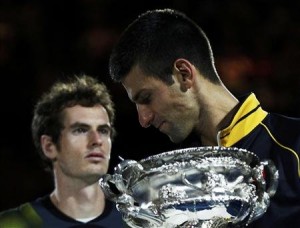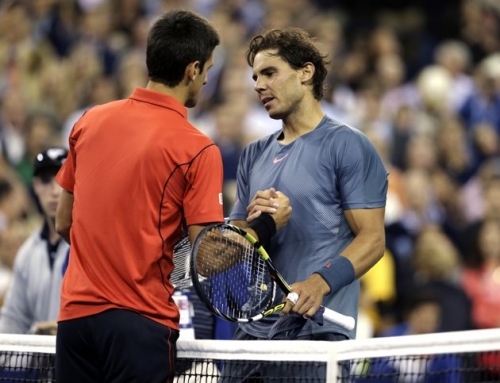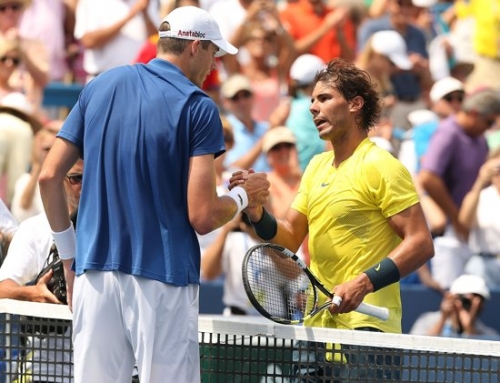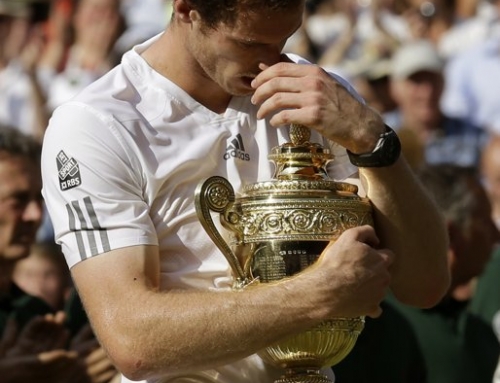 I’ll spend time in this article talking about the tactics used in this match as well as observations.
I’ll spend time in this article talking about the tactics used in this match as well as observations.
Much like the US Open, which was played in windy conditions, Andy Murray decided to play a lot of balls up the middle slightly to the Djokovic backhand. At the US Open, he did this for several reasons. First, it was windy, so shots up the middle avoid misses that might go wide. Second, it reduces the angles on the court. A player like Rafa can often take these middle shots, especially if they float, and curl it to the sidelines. However, Murray was hitting the ball relatively flat, with pace, so it made it harder to attack.
When Djokovic had a chance, he would try to hit the ball inside out to the sideline at Murray’s backhand. This was effective if he landed it well, and often forced Murray to have to slice up, which Djokovic often closed the net to put away a volley. Indeed, if you can point to something, it’s Djokovic coming to net more often, typically on shots like this.
Because Murray was playing so many shots up the middle, the dynamic of the game was a bit more passive and dull. In chess, strategy is often split into one of two broad categories: tactical chess and positional chess. Tactical chess is about trying to use tactics to attack an opponent, and use bold moves to win. Think Federer. Positional chess is about occupying certain parts of the chess board, and use the interrelation of the chess pieces to provide a strong foundation from which its hard to attack. Think Nadal or Djokovic when he’s playing defense.
Murray took a lot fewer chances in this match. He did try to move Djokovic side to side on occasion, and went after a few big shots, but he was struggling with the wide serve of Djokovic, and in general, Djokovic’s serve, that he seemed resigned to play more conservatively.
Oddly enough, Djokovic played the first set better and worse than Murray. On the one hand, Djokovic had Murray in trouble in the early parts of the first set, with break points that Murray worked hard to save. On the other, Djokovic was rolling up unforced errors with his forehands just flying long, somewhat reminiscent of what happened against Wawrinka. Part of the reason Murray struggled early was that he couldn’t get a first serve in for the first few games.
Announcers at ESPN are starting to notice the reason Roger gets aced as much as he does by players like Tsonga, Raonic, Andy Murray. Federer likes to stand just behind the baseline like the best returners of yesteryear: Agassi and Connors. At that close range, Federer is far more vulnerable to being aced. It took years before Agassi could be convinced to back off the serve and buy himself more time. In the same way, Federer is a stubborn man.
While Murray pumped in the aces against Federer, he could barely get aces against Djokovic. Two reasons. First, Djokovic is a better returned than Federer. Second, Murray serves more nervously against Djokovic.
Murray started to serve better in the latter parts of the first set, and so he was holding more easily. Djokovic, meanwhile, was still a bit rattled by Murray, feeling the pressure of a player that has trained, seems strong, and mentally tough. Djokovic opens with a double-fault, and Murray takes advantage. By the end of the tiebreak, one that Murray wins convincingly, Djokovic is starting to doubt himself.
At the start of the second set, Murray gets Djokovic in a 0-40 hole. If Murray wins any of the next few points, Djokovic’s confidence is likely rattled and Murray might take the second set. Instead, Murray has a few bad returns, and Djokovic takes some risks, and manages to win the first game. Djokovic, having fought his way out of this situation, is starting to play more confidently.
Even so, Murray’s serve is also finding its range. Thus, neither server is seriously threatened for the entire set.
One key difference between this match and previous encounters is the length of the rallies. In particular, last year’s semifinal had really long rallies with players moving around. This year, there are very few 20 shot rallies or longer. Murray does try to move Djokovic left and right, but Djokovic is stretching for the shots well, playing great defensive tennis, and Murray is reluctant to try to hit big shots 4-5 times a point, something, say, Federer or Soderling or Berdych would attempt to do.
Apparently, one other difference is how hard each of the players are hitting. Both Murray and Djokovic can hit the ball very hard–in practice. In match situations, players generally dial down the pace some because they need to get the ball in consistently. Players that whack the ball hard a lot often find themselves mired in the rankings: see Lukas Rosol. This may be one reason Murray is playing more shots up the middle. He hits it harder, but takes less risk in doing so.
Murray also struggled in two other spots of his game. First, reacting to overheads. On the one hand, an overhead is something that is hard to deal with. Murray guessed wrong numerous times, but that’s pretty standard. But even when Djokovic hit an overhead Murray could reach, Murray won maybe one point. We’re so used to Federer making shots out of overheads that it’s kind of a shame Murray struggles with that.
But more importantly, Murray didn’t pass very well. Part of it was the pressure Djokovic applied on his approach shots, and part of it was because Murray just prefers to pass crosscourt. He had one great pass down-the-line, but overall, Murray didn’t pass, nor lob well, and this contributed to points Djokovic won at net, where he was quite successful. Murray also didn’t come in very much against Djokovic, maybe less than a dozen times while Djokovic came in about 30 times.
In the second set tiebreak, Murray was ready to make a second serve when he saw a feather dropping slowly. He waited for it to fall, which took a while, then moved it out of the way. At that point, he served a double fault. Murray had had only two double faults the entire tournament, but doubled that in this match. Most of his double faults came in 40-0 situations where he tried to hit a second serve slice curler that missed the line twice. I think the strategy there was to go for his second serve on key situations when he’s up big. Indeed, Murray just kept missing by a little here and there, but those are the slim margins of pro tennis.
With that, Djokovic gained more confidence and Murray makes an error. Djokovic claims control of the tiebreak and wins it. ESPN announcers pointed out that Murray had played better in the second set (though he struggled with return), but was getting frustrated in the tiebreak where he made a few mistakes.
The start of the third set eventually spelled the end of Andy Murray’s chances. Murray was treated for a blister, and he was grabbing at his hamstrings. Although Djokovic also seemed bothered by his hip, it didn’t impact Djokovic, whose confidence was only growing, and it did impact Murray, who suddenly was struggling to chase wide shots that he was making in the first set.
Murray tried, for a game or so, to hit big, and just go corner to corner. But again, it’s so hard to hit through Djokovic. Djokovic tracks these shots down, and can hit it on the full stretch, with solid results. By contrast, Murray had Federer running like a chicken with its head cut off. Djokovic was more effective at chasing shots down. Plus Murray doesn’t hit the ball nearly as accurately as Djokovic, so he can’t hit the ball on a dime moving it left and right. And his flat shots meant that he was clipping the net quite a few times.
With Murray’s impaired movement, it seemed only a matter of time before the match would see its first break. Unlike, say Ferrer-Almagro, where Almagro could still punish the ball without moving well (and Almagro was even more hobbled than Murray), Murray couldn’t even do that because Djokovic retrieves so well.
Throughout this set, Murray also struggles, like he did in the first two sets, getting deep in any of Djokovic’s games. He might hit one great shot to get ahead, but Murray had trouble returning, often slicing shots back. To be fair, Djokovic also struggled with the Murray serve. Murray gets ahead 0-15 at 3-all, but Djokovic comes back to take the rest of the points.
At the start of the 4-3 game, Murray and Djokovic play a 36-shot rally. It’s one of the few points in the match that look like last year’s match. Fans had probably expected more of this kind of rally, but it’s one of the rare ones. Both players are winded, but Murray loses the rally, and it causes him to pull the trigger a bit soon and causes more errors. Murray loses serve–the first loss of serve in the match, and Djokovic is up 5-3. At this point, the match really is over, but it was over earlier when Murray’s movement became hampered and he wasn’t able to chase shots down any more.
Djokovic closed out this set, and with it, Murray’s chances to win dwindle. The only way Murray wins is he goes for broke, or Djokovic gets hurt, and retires. Neither are likely possibilities.
Murray is broken to fall behind 1-3, then broken again to fall back 1-5. He manages to claw his way to hold serve, because he’s in danger of being broken again, to 2-5, but Djokovic finally seals the deal, and wins 6-2.
Although Murray could feel sad about the situation, knowing his body betrayed him, Murray can at least look back at 2012 and realize he won the Olympics and the US Open. Murray says in a post-match interview that he rarely gets blisters, and in any case, many other players have to deal with minor injuries like this, and they still win. But the reality is, with Murray injured, he couldn’t chase shots down. He was already struggling with return of serve, and that made Djokovic even more confident. It’s hard to beat a player of Djokovic’s caliber without being at full steam.
Patrick McEnroe noted, after the match, that it wasn’t the feather that caused Murray to double-fault and lose the second set, that ultimately spelled doom for Murray, but the inability of Murray to break in that first game. To be fair, Djokovic might have fought back anyway, taking chances, but if Murray had broken to love in that first game, Djokovic would still be rattled, and had Murray taken the second set, it might have been a different story.
In a way, this match resembled some of the Shanghai match, though Murray never got to match point as he did in Shanghai. In Shanghai, once Murray lost the second set marathon tiebreak, after holding match points, his body began to cramp, and he was finding it hard to move. Djokovic took advantage in that situation as well. Murray’s goal, should it be attainable, is to figure out how to finish a match strong against Djokovic.
In any case, Djokovic overcame nerves, then relaxed enough to play his game. He served awfully well, which made his job a lot easier. This was not the break-fest that last year’s semi in the Australian Open or last year’s US Open final were where players were broken at least 15 times. There were 3 breaks of serve, all on Murray’s serve, and that was the difference.
Murray can probably take some solace that a blister did him in because he knows the match was pretty even up to that point (the start of the third set). This also means that Djokovic hasn’t taken huge steps ahead of Murray. Although it’s a bitter pill to swallow, one imagines Murray will try to be like Federer (hopefully), forget it, and move on. Certainly, Murray didn’t seem terribly discouraged at the end. A Slam title helps that.
For Djokovic, he continues to show, even while not playing great tennis, that he’s number 1, and he’s now amassed 6 Slam titles (4 Australian Opens, 1 Wimbledon, 1 US Open). Admittedly, it’s piling up in the “weakest” of the 4 Slams (it’s where Agassi got a lot of his Slams too). Djokovic is now seeking to finish the career Slam with a French Open win. It’ll be interesting to see how Rafa comes back, as he’s slated to play the South/Central American clay swing, and only play Indian Wells (skipping Miami). Rafa’s clear goal is to aim for a French Open win.
But Djokovic, having played so well, has to be feeling really confident as well. If he can win the French, then he’ll start to move into the category of players like Agassi or Edberg or Connors or Lendl that are in that middle tier of players that are very good, but not Sampras/Federer good. Djokovic has strong incentive to gain that mental mastery over Nadal like he did in 2011 because if Nadal comes back strong, that’s still the rivalry to beat.




![[US Open Men’s Final] Can Djokovic beat Nadal in the finals?](https://www.essentialtennis.com/wp-content/uploads/2013/09/20130909djokovic-500x383.jpg)


![[French Open] The tactics of the Djokovic-Nadal semifinals](https://www.essentialtennis.com/wp-content/uploads/2013/06/20130607nole-500x383.jpg)